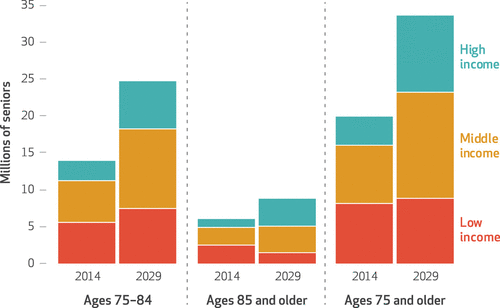
Are you a middle child? My hand is raised. I am the fifth of seven children. There are all kind of great things to say about the first and last born. Those of us born in the middle spend a lifetime with chips on our shoulders.
The same tropes can be applied to the have and have-nots in the last decades of life. Those on the top of the heap enjoy many options with income and investments to sustain a lifestyle of choice. Conversely people with least resources have special programs and funding rightfully provided for their care.
University of Chicago National Opinion Research Center
The University of Chicago National Opinion Research Center 2019 study The Forgotten Middle: Many Middle-Income Seniors Will Have Insufficient Resources for Housing and Health Care. Researchers Caroline F. Pearson, Charlene C. Quinn, Sai Loganathan, A. Rupa Datta, Beth Burnham Mace, and David C. Grabowski conducted the study with grant funding from the National Investment Center for Seniors Housing and Care. Data used data from the Health and Retirement Study (HRS), a nationally representative, longitudinal survey of people ages fifty and older. This study was released in 2019 before the pandemic and economic fallout that remains with us today.
We know that the top and bottom quartiles of this population have a safety net, but the middle lives with a great deal of uncertainty. The researchers seek to define the middle “Who are they? What will their care needs be? Will they have sufficient financial resources to access seniors housing?” I recommend reading the study to understand the statistical methods used to take a snapshot of this cohort’s demographic and socioeconomic characteristics in 2014 and then make projections on their lives in 2029. This study endeavors to forecast “tomorrow’s seniors” those seventy-five years and older in 2029.

Past Performance is Not a Guarantee of Future Results
Even with all the careful multi-variant modeling involved in this work, the final report is careful to state that many of the assumptions may be wrong. In fact, the pandemic may have already blown their predictions. Regardless, we can learn a great deal about the middle from this work (and we middle people deserve the attention!).
Safe, Accessible, and Affordable Housing
Tomorrow’s Senior middle will face painful choices. The researchers predict many in the middle will not have enough money to pay for medical expenses and rent simultaneously. When asked, most people prefer to stay in the community and not move to residential care citing the desire to remain independent for as long as possible. However, mobility limitations may dictate how and where they live in 2029. If housing and health programs remain the same as today, the middle will struggle to find affordable, accessible, and safe housing. The researchers predict that ¾ of one million middles will spend down their assets to qualify for needs-based housing.
Medicare Coverage for Activities of Daily Living and Chronic Care Management at Home
The researchers predict middle income seniors will live with three or more chronic health conditions that will likely impact their ability to perform daily tasks (bathing, dressing, toileting, eating, grooming, and sit to stand transfers). Activities of Daily Living (ADLs) assistance is considered custodial care or non-medical care. Ironically, today’s focus on the Social Determinants of Health lifted the veil on the importance of ADL assistance and adequate housing for curbing health care costs. Medicare and Medicare Advantage plans are sitting on the opportunity to address these issues but where are the incentives?

Caregiver Shortage
I applaud these researchers for highlighting the immense role that unpaid family caregivers play in our senior care system. They caution that smaller families and advanced age of this cohort in 2029, will make today’s caregiver shortage look insignificant. Think about the confluence of events, adult children living further away from aging parents, increased likelihood of widowhood, and social isolation due to pandemics and other social conditions. Tomorrow’s seniors’ upper income group should easily afford the care and the setting of their choice since finances will not be a limitation. The lowest income group will receive care funded by government programs. Once again, the middle will suffer the most with too little income and equity to buy care and too much of the same to qualify for public assistance.
My brothers and I always say, ‘middle kids stick together.’ Now it is time to expand our tribe to include the millions of tomorrow’s seniors middle to demand a care system we deserve.
Yours in Health,
Monica
Monica is the CEO & Founder of REUNIONCare, Inc. a SBA certified Female Owned Business located in St. Petersburg Florida. Monica is a social entrepreneur with a passion to change the way we care for each other.
She is a member of the former member of SBA National Women’s Business Council, the Florida Agency for Healthcare Administration Telehealth Advisory Council, and the AARP Florida Executive Council. She represented the US at the Seoul 50 Plus International Forum South Korea, InnovAging in Italy, and Silver Economy and Ageing Well International Awards in Japan.
Monica received her master’s in social work and master’s in public health from the University of Pittsburgh. A lifetime member of the Delta Omega Omicron Chapter Public Health Honor Society.Distinguished Alumnus Recipient at Seton Hill University. She is a graduate of the USA Office of National Coordination HITECH health information specialist program. She is a certified Health Information Technology Professional by AHIMA and HIMSS and ICD 10 coder.